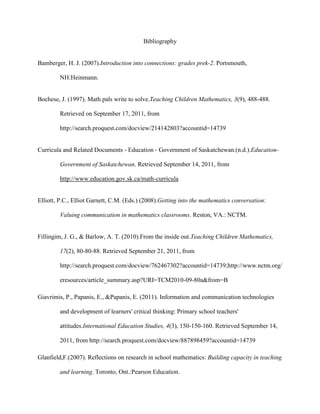Bibliography list EDCUR 805
- 1. Bibliography<br />Bamberger, H. J. (2007). Introduction into connections: grades prek-2. Portsmouth, NH:Heinmann.<br />Bochese, J. (1997). Math pals write to solve. Teaching Children Mathematics, 3(9), 488-488. Retrieved on September 17, 2011, from http://search.proquest.com/docview/214142803?accountid=14739 <br />Curricula and Related Documents - Education - Government of Saskatchewan. (n.d.). Education- Government of Saskatchewan. Retrieved September 14, 2011, from http://www.education.gov.sk.ca/math-curricula <br />Elliott, P.C., Elliot Garnett, C.M. (Eds.) (2008).Getting into the mathematics conversation: Valuing communication in mathematics classrooms. Reston, VA.: NCTM.<br />Fillingim, J. G., & Barlow, A. T. (2010). From the inside out. Teaching Children Mathematics, 17(2), 80-80-88. Retrieved September 21, 2011, from http://search.proquest.com/docview/762467302?accountid=14739; http://www.nctm.org/eresources/article_summary.asp?URI=TCM2010-09-80a&from=B<br />Giavrimis, P., Papanis, E., & Papanis, E. (2011). Information and communication technologies and development of learners' critical thinking: Primary school teachers' attitudes. International Education Studies, 4(3), 150-150-160. Retrieved September 14, 2011, from http://search.proquest.com/docview/887898459?accountid=14739 <br />Glanfield,F.(2007). Reflections on research in school mathematics: Building capacity in teaching and learning. Toronto, Ont.: Pearson Education.<br />Harris, J., Mishra, P., & Koehler, M. (2009). Teachers' technological pedagogical content knowledge and learning activity types: Curriculum-based technology integration reframed. Journal of Research on Technology in Education, 41(4), 393-393-416. Retrieved September 14, 2011, from http://search.proquest.com/docview/274712168?accountid=14739 <br />Kilpatrick, J. & Swaffard, J. & Findell, Bradford (Eds.) (2001). Adding it up: Helping children learn mathematics. Washington, DC: National Academy Press.<br />Kilpatrick, J. & Swaffard, J. (2010). Helping children learn mathematics. Washington, DC: National Academy Press.<br />Kinzer, C.J. & Virag, L. & Morales, S. (2011). Reflective protocol for mathematics learning environments. Teaching Children Mathematics, 480-488. <br />Marzano, R.J. (2005). Classroom instruction that works: Research-based strategies for increasing student achievement. Upper Saddle River, NJ: Pearson Education.<br />Mathematics 2. (2008). Regina: Saskatchewan, Ministry of Education. Retrieved September 10, 2011, from https://www.edonline.sk.ca/webapps/moe-curriculum-BBLEARN/index.jsp?lang=en&XML=mathematics_2.xml <br />Mathern, D., & Hansen, P. (2007). One elementary school's journey from research to practice. Teaching children math, 14(3), 146. <br />Minister of Saskatchewan Learning, Saskatchewan; Minister of Education, Yukon Territory. (2006). The common curriculum framework for k - 9 mathematics: Western and northern curriculum protocol. Edmonton: the Crown in Right of the Governments of Alberta, British Columbia, Manitoba, Northwest Territories, Nunavut Territory, Saskatchewan and Yukon Territory. Retrieved September 21, 2011, from http://www.wncp.ca/media/38765/ccfkto9.pdf<br />Ministry of Education (2010). Renewed curricula: Understanding outcomes. Retrieved September 14, 2011, from http://www.education.gov.sk.ca/Default.aspx?DN=009f8df1-406a-47d8-a44b-cfc25544852b <br />National Council of Teachers of Mathematics. (2000). Principles and standards for school mathematics. Reston, VA.: NCTM.<br />Niess, M. L., Ronau, R. N., Shafer, K. G., Driskell, S. O., Harper, S. R., Johnston, C., . . . . (2009). Mathematics teacher TPACK standards and development model. Contemporary Issues in Technology and Teacher Education (CITE Journal), 9(1), 4-4-24. Retrieved September 17, 2011, from, http://search.proquest.com/docview/822505005?accountid=14739; http://www.citejournal.org/articles/v9i1mathematics1.pdf <br />OŌĆÖConnell, S. & OŌĆÖConner, K. (2007). Introduction into communication: Grades prek-2.Portsmouth, NH: Heinmann.<br />Polly, D. (2011). Technology to develop algebraic reasoning. Teaching Children Mathematics, 17(8), 473-477.<br />Reys, B. J., Reys R.J., Rubenstein R (Eds.) (2010). Mathematics curriculum: Issues, trends, and future directions: Seventy-second yearbooks. Reston, VA: National Council of Teachers of Mathematics.<br />Rosen, D., & Hoffman, J. (2009). Integrating concrete and virtual manipulatives in early childhood mathematics. YC Young Children, 64(3), 26-26-29, 31-33. Retrieved September 13, 2011, from http://search.proquest.com/docview/197632175?accountid=14739 <br />Schwab, T. (2009). The struggle of mathematics implementation. Vinculum, 1(2), 10-12.<br />Schwarz, J. C. Vocabulary and its effects on mathematics instruction. Report: ED439017.102pp.Dec 1999, Retrieved on September 17, 2011, from http://search.proquest.com/docview/62408647?accountid=14739 <br />Silver, E. A., Mesa, V. M., Morris, K. A., Star, J. R., & Benken, B. M. (2009). Teaching mathematics for understanding: An analysis of lessons submitted by teachers seeking NBPTS certification. American Educational Research Journal, 46(2), 501-501-531. Retrieved September 13th, 2011, from http://search.proquest.com/docview/200447504?accountid=14739 <br />Stigler, J. W. & Heibert, J. (2009). The teaching gap: Best ideas from the worldŌĆÖs teachers for improving education in the classroom. New York, NY: Free Press.<br />Sturdivant, R. X., Dunham, P., & Jardine, R. (2009). Preparing mathematics teachers for technology-rich environments. Primus: Problems, Resources, and Issues in Mathematics Undergraduate Studies, 19(2), 161-161-173. Retrieved September 12, 2011, from http://search.proquest.com/docview/213449856?accountid=14739<br />Suh, J., & Fulginiti, K. (2011). Using technology to understand rate of change. Teaching Children Mathematics, 18(1), 56-58.<br />Walshaw, M., & Anttony, G. (2008). The teacher's role in classroom discourse: A review of recent research into mathematics classrooms. Review of Educational Research, 78(3), 516-516-551. Retrieved September, 12, 2011, from http://search.proquest.com/docview/214115647?accountid=14739<br />Wang, F., Kinzie, M. B., Mcguire, P., & Pan, E. (2010). Applying technology to inquiry-based learning in early childhood education. Early Childhood Education Journal, 37(5), 381-381-389. doi:10.1007/s10643-009-0364-6<br />Yelland, N., & Kilderry, A. (2010). Becoming numerate with information and communications technologies in the twenty-first century. International Journal of Early Years Education, 18(2), 91-91-106. Retrieved from http://search.proquest.com/docview/757170396?accountid=14739; http://www.informaworld.com/openurl?genre=article&id=doi:10.1080/09669760.2010.494426 <br />




